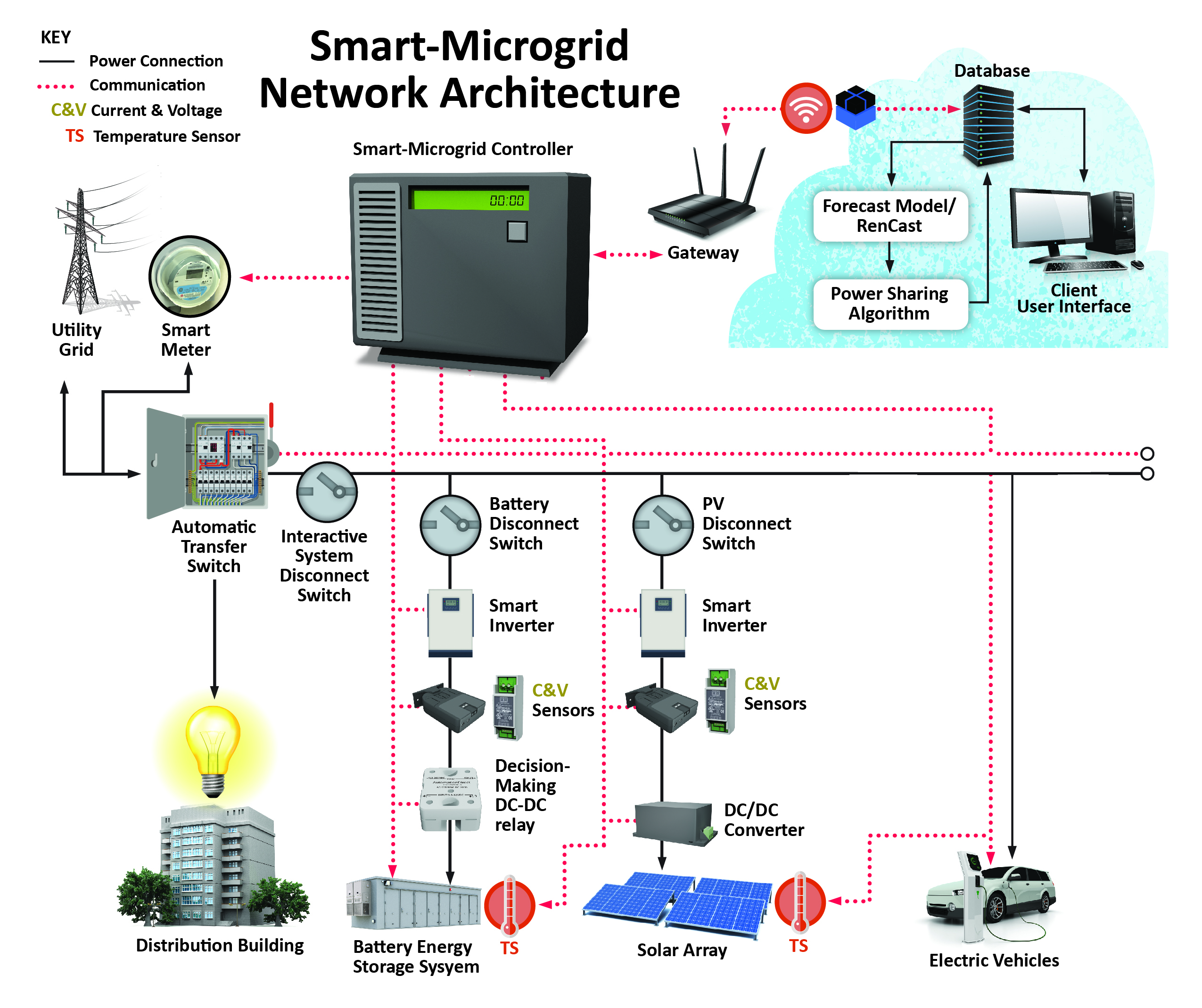
STAT-EI’S SMART MICROGRID TECHNOLOGY SOLUTIONS
STAT-EI’S SMART MICROGRID TECHNOLOGY SOLUTIONS
Microgrids
A microgrid is a local energy grid controlled locally that can exist in isolation or be disconnected from a ‘traditional’ grid and operate autonomously. Microgrids can be powered by distributed generators, batteries energy storage systems, and/or renewable resources such as solar panels.
Microgrids can run indefinitely depending on how they are fueled and managed, and generally are more efficient than traditional energy generation solutions.
Because microgrids often operate in isolation, they must balance load demands and supply capabilities—or they risk under-voltage, frequency variations, or can crash. Microgrids use local storage techniques such as batteries to address challenges include “black starts” (starting up and facing the entire microgrid load in the absence of large generator back up) or switching back, and synching, onto a macrogrid.
Losing electricity can be life-threatening to hospitals, emergency services, communications networks (including cellphones), airports, data centers, senior centers, and shelters. In these instances, microgrids can power emergency response efforts to address outages and improve grid resiliency.
STAT-EI Patented Smart Microgrid Technology, and Wireless Power Transfer Solutions Mitigate Renewable Energy’s Challenges
STAT-EI’s patented smart microgrid technology is uniquely suited to implement microgrids. These patents were designed and developed by Prof. Arif Sarwat (US11022720B2, US10969436B1).
Rencast Battery SOC Forecaster
In this we combine renewable energy and energy storage with artificial intelligence algorithms to manage microgrids. As a result, microgrids can come fully ‘online’ within milliseconds (most generators take seconds to tens of seconds) and can dynamically balance loads faster other technologies. Our artificial intelligence can be pre-loaded with facility-specific load knowledge and fine-tuned to address specific load challenges to allow our microgrids to seamlessly connect and disconnect from the network (grid) at any time.
STAT-AI’s secure and accurate forecasting energy tools eliminate one of the biggest barriers that renewable source plants face—forecasting generation. Our patented technology can forecast renewable energy generation (for five minutes, tomorrow, or next week) with 95% accuracy.
STAT-EI’s Smart Microgrid technology helps customers manage and combine power sources, including renewable ones, to improve the power system’s resiliency. STAT-EI’s patented algorithms address situations where renewable energy ‘penetration’ is deep compared to conventional thermal sources–and is critical when energy storage is included. We use connected batteries to dynamically moderate frequency and voltage effectively manage microgrids ‘black starts’. Our technologies use a grid-forming inverter to connect and disconnect from the grid, and perform black start’ to independently restart the grid when it is down.
STAT-EI’s virtual power plant software component includes predictive and prescriptive computation models to address and mitigate the concerns facing the grid’s high-penetration renewable energy systems (RES) scenarios. Our HOPES controller connects microgrids to the utility grid through their transmission lines to communicate and create a virtual power plant that distributes power where it is needed.
We easily manage and optimize the operation of renewable energy smart microgrids that may be connected/disconnected from the grid without notice, or used as a backup during extreme weather events (e.g., hospitals or other buildings where power continuity is essential) and manage dispersed battery assets, including grid and home batteries.
STAT-EI Patented Smart Microgrid Technology, and Wireless Power Transfer Solutions Mitigate Renewable Energy’s Challenges
STAT-EI’s patented smart microgrid technology is uniquely suited to implement microgrids. These patents were designed and developed by
Prof. Arif Sarwat (US11022720B2, US10969436B1).
Rencast Battery
SOC Forecaster
In this we combine renewable energy and energy storage with artificial intelligence algorithms to manage microgrids. As a result, microgrids can come fully ‘online’ within milliseconds (most generators take seconds to tens of seconds) and can dynamically balance loads faster other technologies. Our artificial intelligence can be pre-loaded with facility-specific load knowledge and fine-tuned to address specific load challenges to allow our microgrids to seamlessly connect and disconnect from the network (grid) at any time.
STAT-AI’s secure and accurate forecasting energy tools eliminate one of the biggest barriers that renewable source plants face—forecasting generation. Our patented technology can forecast renewable energy generation (for five minutes, tomorrow, or next week) with 95% accuracy.
STAT-EI’s Smart Microgrid technology helps customers manage and combine power sources, including renewable ones, to improve the power system’s resiliency. STAT-EI’s patented algorithms address situations where renewable energy ‘penetration’ is deep compared to conventional thermal sources–and is critical when energy storage is included. We use connected batteries to dynamically moderate frequency and voltage effectively manage microgrids ‘black starts’. Our technologies use a grid-forming inverter to connect and disconnect from the grid, and perform black start’ to independently restart the grid when it is down.
STAT-EI’s virtual power plant software component includes predictive and prescriptive computation models to address and mitigate the concerns facing the grid’s high-penetration renewable energy systems (RES) scenarios. Our HOPES controller connects microgrids to the utility grid through their transmission lines to communicate and create a virtual power plant that distributes power where it is needed.
We easily manage and optimize the operation of renewable energy smart microgrids that may be connected/disconnected from the grid without notice, or used as a backup during extreme weather events (e.g., hospitals or other buildings where power continuity is essential) and manage dispersed battery assets, including grid and home batteries.

